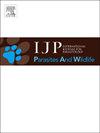鲷鱼(鲤科)寄生虫斑纹纹蝽(桡足目:蜥足科)的新鉴定特征
IF 2
3区 医学
Q3 ECOLOGY
International Journal for Parasitology-Parasites and Wildlife
Pub Date : 2025-07-02
DOI:10.1016/j.ijppaw.2025.101108
引用次数: 0
摘要
寄生桡足动物Tracheliastes maculatus Kollar, 1835,感染了欧洲淡水生态系统中的重要物种——淡水鲷鱼。尽管其广泛存在并可能导致皮肤出血、鳞片侵蚀和穿孔以及鱼类死亡,但由于缺乏足够的诊断特征,对Tracheliastes属的物种水平鉴定一直存在问题。本研究通过整合形态学和遗传学方法来完善鉴定标准。本文首次获得了黄斑Tracheliastes maculaus的DNA条形码(COI基因序列),为黄斑Tracheliastes的分类澄清提供了分子基础。此外,扫描电镜(SEM)显示了新的形态学细节,包括天线的内足爪1上的次级小齿的数量和分布模式,以及天线的内足爪和外足爪侧小齿的结构差异,这些都可能作为该属的新的诊断特征。此外,我们认为莫氏Tracheliastes mourkii是一种女性裸体,因为它没有经过形态学诊断,也没有现存的博物馆标本。这些发现改善了物种的区分,为今后对链蚧的分类修订奠定了基准,促进了更精确的生态学和寄生虫学评估。还提供了该属的一个小型综述。本文章由计算机程序翻译,如有差异,请以英文原文为准。

New identification traits of Tracheliastes maculatus (Copepoda: Lernaeopodidae), a parasite of bream, Abramis brama (Cyprinidae)
The parasitic copepod Tracheliastes maculatus Kollar, 1835, infects the freshwater bream, Abramis brama, a key species in European freshwater ecosystems. Despite its widespread occurrence and potential to cause skin hemorrhages, scale erosion and perforation, and fish mortality, species-level identification within the genus Tracheliastes has been problematic due to insufficient diagnostic traits. This study refines identification criteria by integrating morphological and genetic approaches. We present the first DNA barcode (COI gene sequence) for Tracheliastes maculaus, providing a molecular basis for taxonomic clarification. Additionally, scanning electron microscopy (SEM) reveals novel morphological details, including the number and distribution pattern of secondary denticles on endopodal Claw 1 of the antenna and structural differences in endopodal and exopodal side denticles of the antenna, both of which, may serve as new diagnostic features within the genus. Furthermore, we regard Tracheliastes mourkii as a nomen nudum because it was not morphologically diagnosed, and no museum specimen is extant. These findings improve species discrimination and set a benchmark for future taxonomic revisions of Tracheliastes, facilitating more precise ecological and parasitological assessments. A mini-review of the genus is also provided.
求助全文
通过发布文献求助,成功后即可免费获取论文全文。
去求助
来源期刊

International Journal for Parasitology-Parasites and Wildlife
Medicine-Infectious Diseases
CiteScore
3.80
自引率
5.60%
发文量
113
审稿时长
45 days
期刊介绍:
The International Journal for Parasitology: Parasites and Wildlife (IJP-PAW) publishes the results of original research on parasites of all wildlife, invertebrate and vertebrate. This includes free-ranging, wild populations, as well as captive wildlife, semi-domesticated species (e.g. reindeer) and farmed populations of recently domesticated or wild-captured species (e.g. cultured fishes). Articles on all aspects of wildlife parasitology are welcomed including taxonomy, biodiversity and distribution, ecology and epidemiology, population biology and host-parasite relationships. The impact of parasites on the health and conservation of wildlife is seen as an important area covered by the journal especially the potential role of environmental factors, for example climate. Also important to the journal is ''one health'' and the nature of interactions between wildlife, people and domestic animals, including disease emergence and zoonoses.
 求助内容:
求助内容: 应助结果提醒方式:
应助结果提醒方式:


